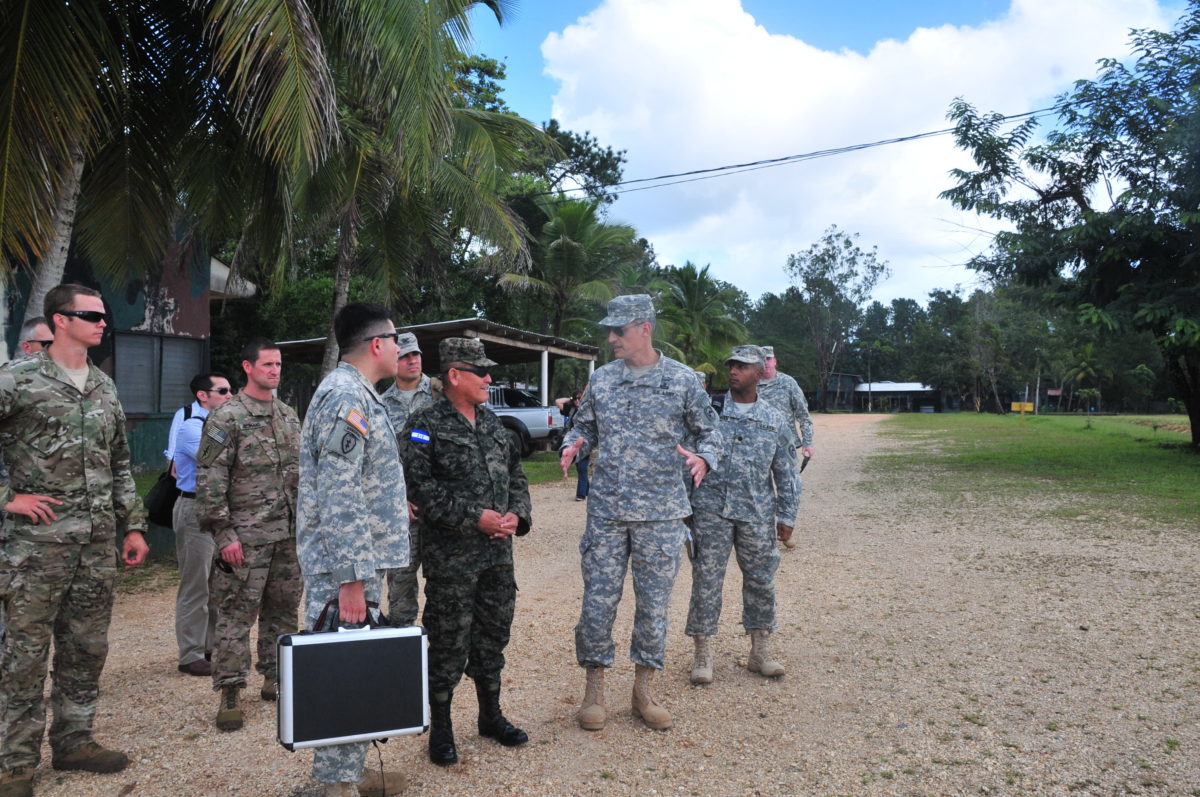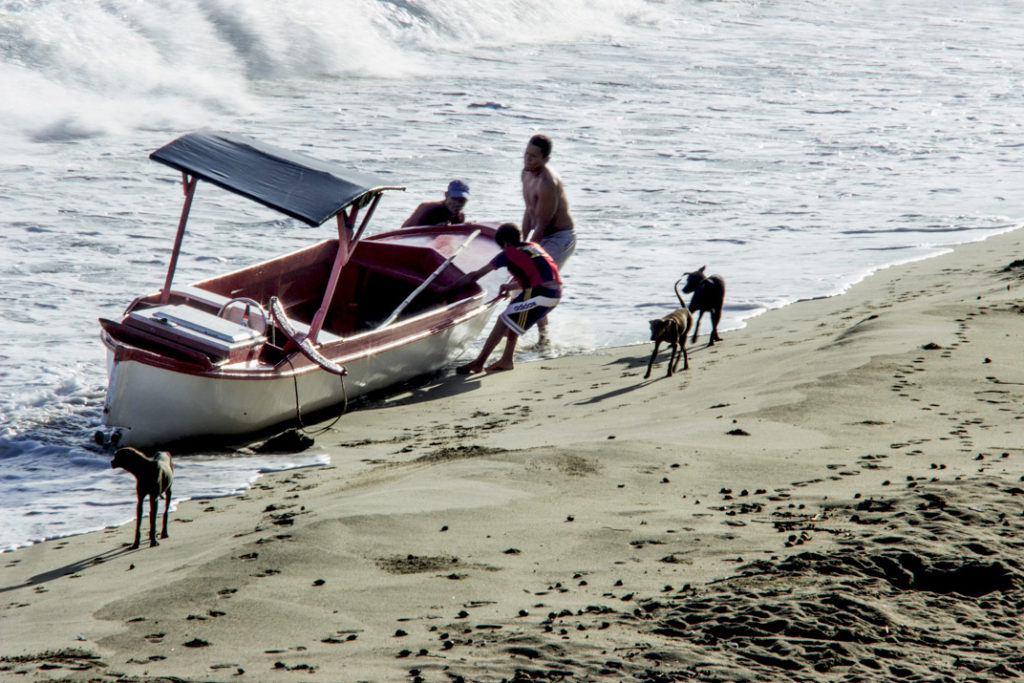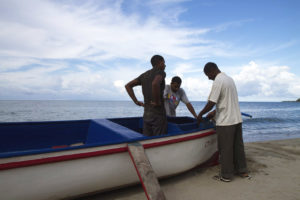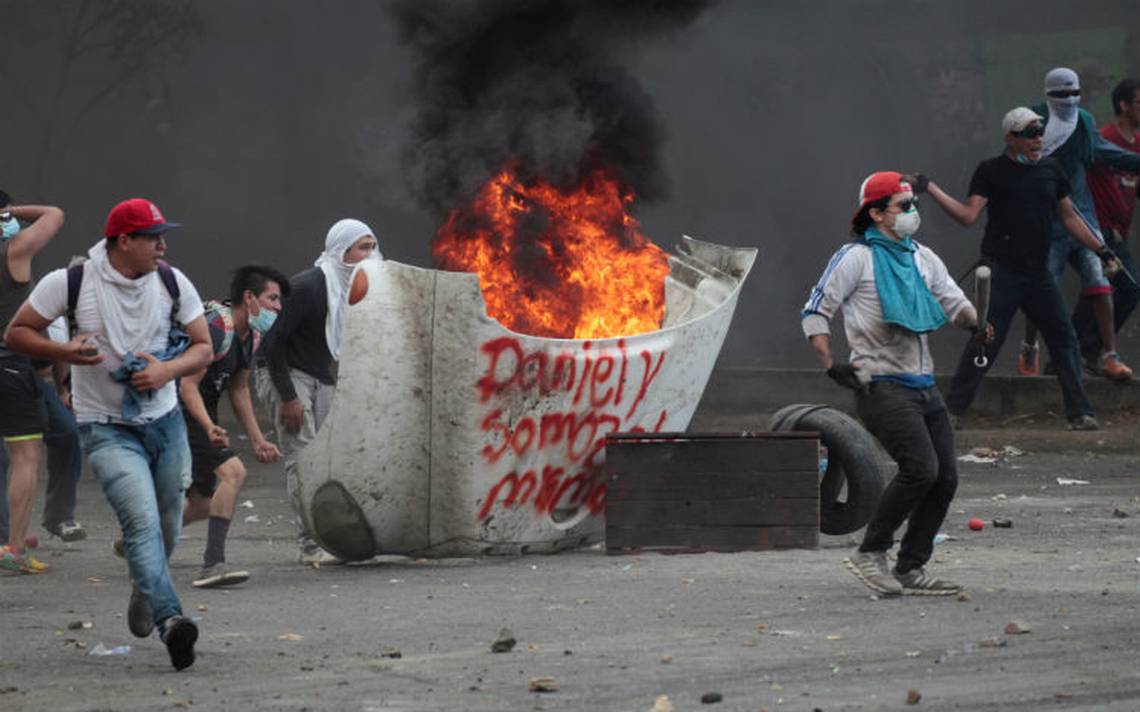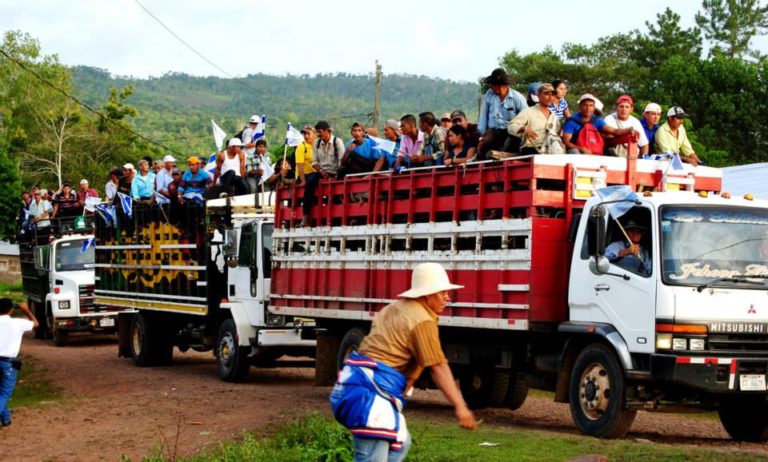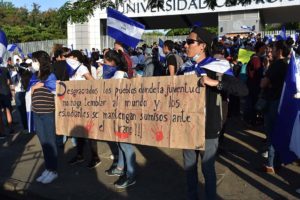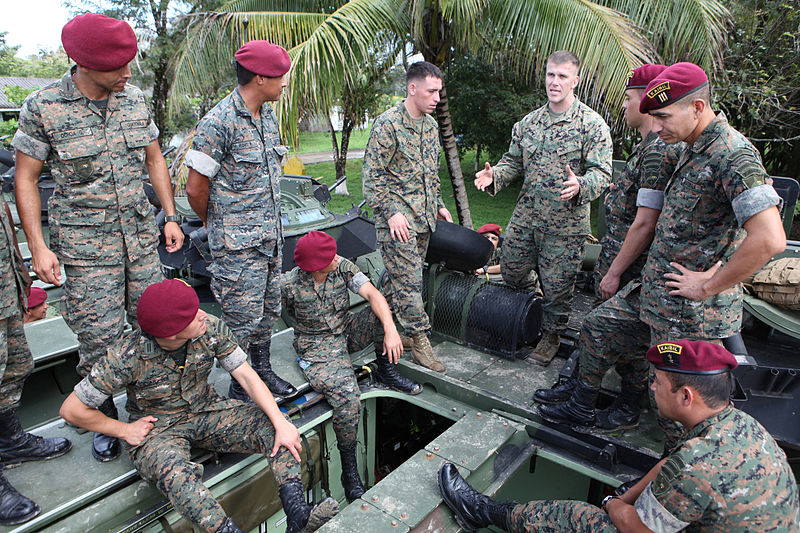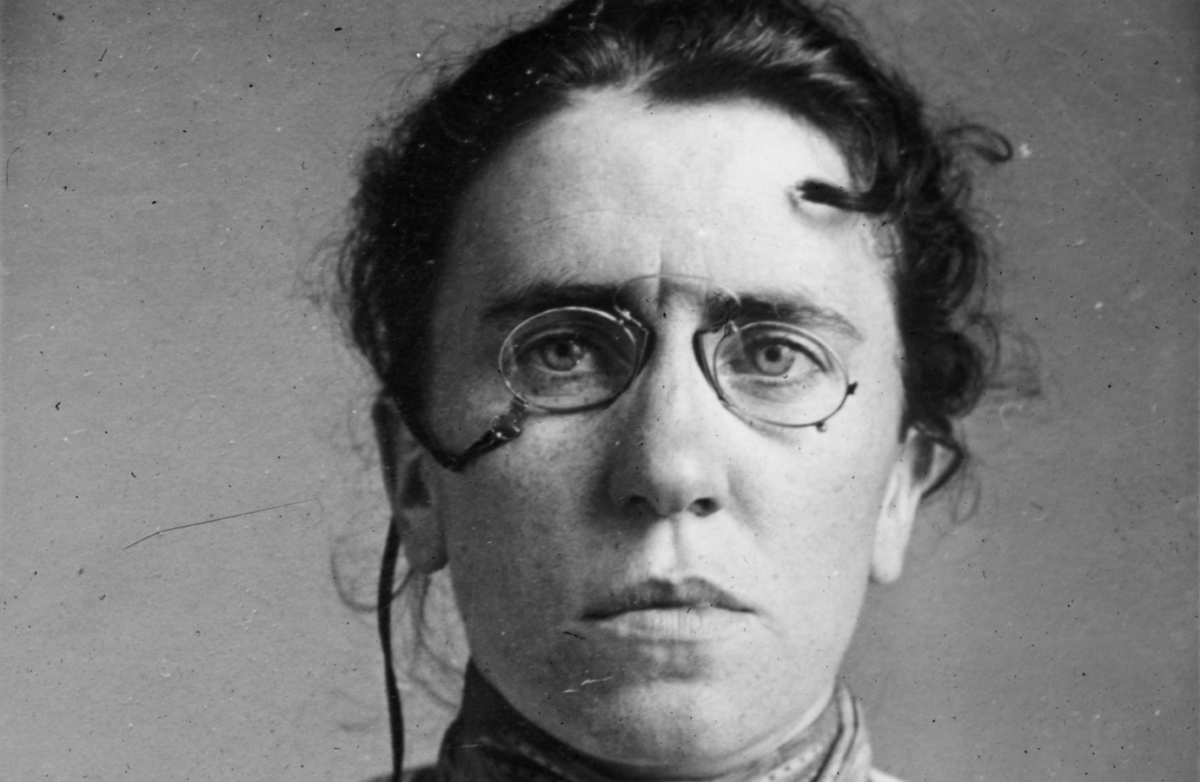The United States Southern Command has launched its new 2017-2027 THEATER STRATEGY. “This plan is our model to defend the access routes from the south of the American continent to its interior and promote regional security through the degradation of threats by transregional and transnational illicit networks (T3Ns), immediate response to any type of crisis (natural or human disaster) and forming relations to confront global challenges”, outlines the strategy document presented by Kurt Walter Tidd, current Commander of the United States Southern Command.
The United States Southern Command (USSOUTHCOM) is one of nine military commands belonging to the United States. It encompasses the area relative to the south of the American continent, Central America, and the Caribbean. It is headquartered in Miami, Florida.
In this strategy, the Sothern Command resizes its presence in Latin America considering that transregional and transnational illicit networks extend beyond transnational criminal organizations and gangs to violent extremist organizations ideologically motivated such as the Islamic State of Iraq and the Levant (ISIL), and Lebanon’s Hezbollah. It also considers among its threats the presence of China, Russia, and Iran in that region.
According to the documents of this new strategy, “the Violent Extremist Organizations focus on spreading their influence and form a network of supporters and radicalized followers—including foreign terrorist fighters—especially in vulnerable populations in the Caribbean and parts of South and Central America”.
Mexican Anthropologist Gilberto López y Rivas points out to Avispa Midia that what the United States government is doing with its rhetoric of defending democracy and humanitarian aid is “a form of Global State Terrorism and, in the countries the United States considers its allies, a State Local Terrorism is replicated, as in the case of Colombia and Mexico”.
The strategy document is clear in assuming that it wants to strengthen relations in the region. “Naturally, these strategic challenges also present opportunities to promote security and regional stability. During the last five decades, SOUTHCOM worked diligently to obtain—and maintain—the region’s trust. Now we propose to develop this trust to deepen the bilateral cooperation and broaden the cooperation to trilateral, multilateral or transregional dimensions. For example, we are encouraging Pacific countries such as Chile, Colombia, and Peru to improve the integration and exportation of the best security practices to Asian and Pacific partners”, the document states.
The strategy confirms that there already exists an established network in Latin America and the Southern Command which aims to “cultivate a network of allies and partners and undertake our activities as part of a thorough effort through this integrated network comprised of: The Joint Force, intergovernmental agencies, multinational agencies and non-governmental organizations”, according to the 2017-2027 THEATER STRATEGY document.
Civil Society
At the same time, the strategy ranks its operations from civil society, academia, and the social and military organizations. “SOUTHCOM will partner with civil society, the academic sector, the private sector and the populations that extend the governance, improve the community’s resilience, broaden the social and economic opportunities and help the vulnerable populations resist the corrupt influence from the existing threats and illicit networks, and from wicked or perverse external actors”, asserts the new strategy.
“In each of our countries, the agencies are embedding themselves in the police and military structures that provide them intelligence to carry out their actions. I have already pointed to the type of relationship that all the military forces have with what they call the host nations. These host nations are in charge of carrying out their war or internal counterinsurgency”, says anthropologist López.
The Mexican researcher adds that drug traffickers function “like a paramilitary force or at the service of the armed security forces. In the case of Mexico, they are the other side of the clandestine Armed Forces, which are used to criminalize [movements that resist government policies]. The mining companies call this Conflict Engineering, which is how mining corporations impose their presence in a region by using criminals who are protected by security corporations.”
The main military influence areas for the Southern Command are the Task Forces located in each of the countries of Central and South America. Implementation of the new strategy links “Components, Joint Task Forces, and Security Cooperation Organizations (SCO)”.
SOUTHCOM exercises, the document says, “its legal authority as a Combatant Command to fulfill missions through its components of each service, Joint Task Force and other organizations which regularly carry out exercises, operations, and exchanges of experts from different fields. The Armed Forces (Army, Navy, and Air Force) provide SOUTHCOM with command components that carry out the specific objectives of the mission and the security cooperation activities”.
The strategy emphasizes one of its main areas of influence in Central America, the Joint Task Force-Bravo, which operates in the Honduran military facilities in Soto Cano Air Base, located in Comayagua Valley, Honduras. Its staff is composed of more than 500 United States military men and 500 American and Honduran civilians. In also considers the Guantanamo Bay Joint Task Force, located in Guantanamo Bay, Cuba; the Joint Interagency Task Force South (JIATF-South), located in Cayo Hueso, Florida.
These United States military areas coordinate their actions with interagency units located within the teams of each country of the United States Embassy. “Working with interagency partners such as the Department of State (DOS), the United States Agency for International Development (USAID), the Department of Homeland Security, the Department of Treasury, the Department of Justice, and the collaboration with the ONGs and intergovernmental, business, and academic organizations allows us to move towards national objectives that would be impossible to achieve solely with military power”, the 2017-2027 THEATER STRATEGY document points out.
Read also ⇒ The US Southern Commands Silent Occupation of the Amazon
“Trump is trying to recover the ground lost during the last decade by the progressive governments and wants to take a strong stance due to the presence of China and Russia. China is being a reflected as a model of development for the countries of the region. This is where the United States sees a problem in the region. Unlike the United States, China is making its presence economically and not militarily”, said researcher Wolf Grabendorff, from the Andean University Simon Bolivar of Ecuador in a correspondence with Avipa Midia.
In Grabendorff’s opinion, in a scenario in which the United States is losing economic presence, “what remains as a last resort a military presence”.
United States & NATO Military Bases in Latin American & the Caribbean
The objective of the military base is ‘to protect the interests of North American companies” in the Neuquén zone.
Oil, A Strategic Motive
The Southern Command had previously launched a strategy for the 2008-2018 decade, which is now coming to an end, entitled United States Southern Command Strategy 2018 Partnership for the Americas. Among the economic title, they looked to secure the supply of oil and natural gas. According to the United States Department of Energy, in 2008, three of the four main energy suppliers for this country were located in the western hemisphere (Canada, Mexico and Venezuela). Likewise, the Coalition for Affordable and Reliable Energy projected that the United States would need 31% more oil and 62% more natural gas in the following two decades, 2008-2028.
“As the United States continues needing more oil and gas, Latin America become a global leader in energy with its enormous oil reservations and production and supply of gas and oil. We must work together to guarantee that these energy resources and the infrastructure that supports them allow for regional prosperity”, the official 2008-2018 strategy document argued.
The Argentine province, Neuquén, took a geopolitical turn. In 2011, one of the most important deposits of gas and unconventional oil in this country, Vaca Muerta, was discovered. This deposit is located in Neuquén Basin. It has a surface of 30 thousand km2. According to the Argentine company Yacimientos Petrolíferos Fiscales (YPF)—Fiscal Oilfields—in Vaca Muerta there are 117 trillion cubic feet of shale gas and 40 billion barrels of unconventional oil which is already extracted using the hydraulic fracturing method (fracking).
Read also ⇒ Fracking Expands in Latin America, Threatening to Contaminate World’’s Third-Largest Aquifer
Argentina went on to lead, after China, the list of nations with most “technically recoverable” reserves of shale. But it also reconfigured its geopolitical position. During 2017, Tom Cooney, who was then North American interim ambassador, had visited the Neuquén province and ratified the intention to reactivate a military base construction for humanitarian aid. At the same time, he highlighted the investments made by Chevron and Exxon Mobil in Vaca Muerta.
The objective of the military base is to “protect the interests of North American companies” in the Neuquén zone, according to Mariano Mansilla, an Argentinian deputy.
However, the General Secretary of the Provincial Government of Neuquén, Leonel Dacharry, holds that “this is not about a military base, but about the Humanitarian Assistance Program that will resume the work that was suspended in 2012 and which consists of a deposit and an office building for the coordination of the Civil Defense and other agencies in case of an emergency”.
In addition, Albert Kraaimoore, interim minister advisor of the United States, who led one of the last American delegations that visited the Neuquén province on March 22 and 23 of 2018 said, “we are visiting many provinces but, especially, it is very important for us to get to know Neuquén better, because there are a lot of interests in what is happening in this very young province and because of the growth of the oil industry. I think we have something to share with you. There are many American companies that have seen a great change here in Argentina. There are many who are coming to make their investments, especially in Neuquén, big companies like Chevron and Exxon”.
The former U.S. ambassador to Argentina, Tom Cooney, emphasized that the tours in these provinces have been taking place since 2009 and that “the donation for humanitarian assistance further increases the capacity of the province to respond and prepare for natural disasters”. Mr. Cooney was a Foreign Policy Advisor for the U.S. Department of State. During his time in Washington, Minister Cooney worked closely on topics related to the fight against terrorism in Latin America.
In February of this year, 2018, in the framework of the official visit to the United States, the Minister of Security of Argentina, Patricia Bullrich, along with the Secretary of Interior Security Gerardo Milman, were welcomed in Florida by Admiral Kurt Walter Tidd, current head of the Southern Command. Among other points, they addressed the upcoming thirteenth G20 meeting that will be held for the first time in the Southern Cone on November 30th and December 1st of this 2018 in Buenos Aires, Argentina. In these meetings, dialogues with the FBI and the DEA were drawn. The Minister returned to her country with the commitment to create a Task Force against international crime and drug trafficking for the northeast region of Argentina, with the support of intelligence analysts from the DEA.
“This compromise includes more analysts that will help us analyze where the drugs are coming from”, said Bullrich.
“Hezbollah is a concern to the United States in this region because “it came up in every meeting we had.” - Patricia Bullrich, Minister of Security of Argentina
According to the official, “official U.S. reports identifying several potential terrorists in the Triple Frontier between Argentina, Brazil and Paraguay” were presented in the meetings.
“Hezbollah is a concern to the United States in this region”, says Bullrich, because “it came up in every meeting we had”. In the same way, Gerardo Milman also added that, “it is very important for our government to be able to collaborate with them [the United States] and vice versa. We have offered them a joint task in the Triple Frontier due to terrorism issues, and we believe we may also work with other agencies, in addition to the DEA, that will allow us to have a deeper look into what is happening there”.
Researcher Grabendorff contradicts this vision. “I don’t find it adequate for people to label any sort of activity as terrorism where there is only a Molotov. Terrorism is something else”, points out the German political scientist Grabendorff to Avispa Midia.
“The word terrorism is a very important word for the relationship of the United States with other countries. This is the case of Argentina with Mauricio Macri, the current president of this country”, says Grabendorff.
It seems that the presence of the Southern Command goes beyond terrorism, drug trafficking and oil. The Triple Frontier constitutes the geographical point where the borders of Argentina, Paraguay and Brazil converge, coinciding with the Iguazú River mouth in the Paraná River. The Guarani Aquifer System is located in this area, which is one of the main reservoirs of underground fresh water in the world. Based on a study conducted by the Military Center for Argentine Democracy, the Guarani Aquifer would have a capacity of approximately 50,000 km3, with an annual recharge of 160 Km3 to 250 Km3, such that exploiting some 40 Km3 annually could provide 360 million people with about 300 liters of water daily per inhabitant.
Friendly Relations
The humanitarian aid in the face of natural disasters, the response against illicit organized crime networks, and terrorism have been the lines by which the “United States Southern Command Strategy 2018 Partnership for the Americas” has been implemented from 2008 to 2018. That strategy sought to strengthen ties with its international partners to support “security and stability” of the region. During this period, many diverse military operations have been carried out to promote the security cooperation and reach the strategic objectives of the United States.
“The Southern Command’s present strategy is to create closer relationships with the nation-states, with the police and military units, mainly due to the presence of China and Russia in the region. Under progressive governments it was not that easy to trace those relationships, and today, they return in the form of humanitarian aid, training, and the politics against drug trafficking and terrorism”, adds the German political scientist Wolf Grabendorff, an international consultant on issues of international relations and security in Latin America.
For Grabendorff, there are several processes of reorganization of the United States in the Southern Cone. For example, he warned that “after the United States military bases closed in Ecuador they moved to Peru and Colombia, we must pay attention there”.
According to the United States Embassy in Peru, “in total, since 2007, the United States government is providing more than $44 million to Peru in 277 projects, through its Humanitarian Assistance Program (HAP), to help Peru improve its capacity to respond to disasters.” Among other projects is the new Regional Emergency Operations Center of Huánuco financed by the Southern Command that will be used to “improve the response capacity to natural disasters. The investment in this center goes above $1.5 million”, said Jorge Chávez Cresta, a Southern Command representative.
In addition, in August 2017, the head of the Southern Command, Kurt Walter Tidd, in the framework of the South American Defense Conference-2017 (SOUTHDEC 17), held in Lima, Peru, said that “this meeting demonstrates our interest in strengthening relations with the countries of this region, to join as partners and true friends who welcome all ideas and perspectives.
The South American Defense Conference is one of three regional security conferences that the United States Southern Command carries out to “exchange experiences among defense and security authorities of the region”, including on the issue of “climate change”.
A month prior to this meeting, the Southern Command had carried out a military exercise by sea, air and land called Multinational Exercise UNITAS—2017. More than 4,200 sailors from 19 countries, and approximately 60 naval, terrestrial and aerial units, participated in the “Mar de Grau” off the northern coast of Peru, in its fifty-eighth edition of these exercises. The United States, Argentina, Australia, Brazil, Canada, Chile, Colombia, the Dominican Republic, Ecuador, Guatemala, Honduras, Indonesia, Italy, Mexico, Panama, Paraguay, Spain and the United Kingdom, as well as the Peruvian Armed and Air Force, participated in this international exercise.
“Colombia is the United States’ most important ally in the region. Colombia could be the Trojan horse in an eventual military intervention against Venezuela or against any country in the region, according to their interests”, points out Gilberto López y Rivas, who is an author of “Estudiando la Contrainsurgencia de Estados Unidos” (Analyzing the United States’ Counterinsurgency), among other books.
In addition to these military exercises, others were carried out in the Triple Frontier shared by Brazil, Colombia and Peru, with the multinational military exercise titled AmazonLog2017, organized by the Brazilian Armed Forces with support from the Southern Command. At least 2,000 Brazilian military men participated, as well as men from the invited countries, with high-caliber weapons and ammunition, ships, planes and helicopters, information technologies, nautical equipment, smart energy, radars and sensors.
“Under military dictatorship in Brazil, these joint exercises with the United States never took place. This is the first time, since they were aided in World War II, in which the Brazilian government helps this North American country carry out these exercises. This is a very significant historical geopolitical change”, said Grabendorff.


